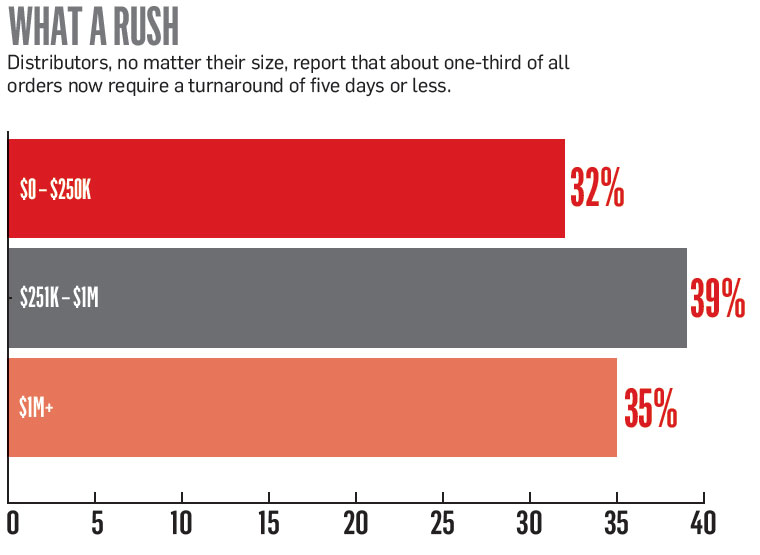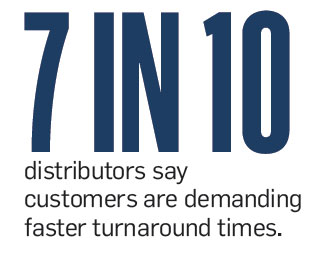Awards July 20, 2017
The Need for Speed
In the digital age, customers want everything faster – and distributors have to oblige.
It’s an Amazon world out there. No matter what they’re buying, customers now expect companies to fulfill and ship their orders in just a few days – sometimes less. This isn’t just true in B2C, but B2B, as well. State of the Industry data shows that 70% of distributors say customers demanded faster turnaround times in 2016.
>>Back to the State of the Industry 2017
“Rush orders are becoming the norm these days,” Robin Richter, president of Wearable Imaging (asi/356030), says. “Our clients have way more on their plates, and promo items are sometimes a last-minute add-on. We have to keep up with the Amazons of the world.”
Robert Rosenthal, CEO of JP Promotional Products Inc. (asi/232668), agrees, noting that his firm handles all sorts of rush orders. Some clients request a reasonable five-day turnaround, while others call in the morning and want to pick an order up later that afternoon.
In order to meet these demands, distributors need to rethink the way they do business, starting with how customers see products online to begin with.
“Try to direct the customers to places where you know you can meet their needs faster at better quality and better cost versus giving them the entire field of what’s available,” says Joe Adamski, a senior manager at global consulting firm A.T. Kearney. “If it’s possible to build a framework where you know what your customer’s going to do, then you can work with suppliers to make sure you’ve got the right inventory in the right place available at the right time.”
To that end, Wearable Imaging has a special section on its website called “24-Hour Rush,” which links to products that can be available for shipment in just a day. On the back end, Richter says the process is a speedy one. First, the salesperson calls the supplier to ensure stock and verify ship time. At the same time, the client receives a virtual proof to approve art immediately, and that image is attached to the order for the supplier as ready to go – no proof needed.

“Make sure to have great connections with your vendors so you can easily get these orders in and processed quickly,” Richter says. “The vendor plays a big part in making sure your order gets out the door on time.”
Both Richter and Rosenthal have a list of suppliers that provide rush orders and match those suppliers to customers by distance. “Once we identify the product and the speed needed, we identify a supplier close to the customer to minimize shipping costs,” Rosenthal says. “We have even had customers pick up orders at local suppliers.”
The unpredictability of rush orders is no doubt one of the biggest concerns distributors face. Promo firms must be prepared at all times to change gears and focus on a different order that’s urgent. Richter says it “keeps us on our toes,” and Rosenthal puts rush orders at top priority.
“Most often, the customer doesn’t know they need something until the last minute,” Rosenthal says. “When I started in this industry, if you told a customer they could have their order in four to six weeks, they would be thrilled. Now, society in general wants and expects everything the next day. B2C sites like Amazon and eBay are training everyone to expect fast delivery, and this has extended to our world of promotional products.”
There are, though, real positives in accepting rush orders. Both Richter and Rosenthal see this as a way to attract and retain new clients. If an extra 5%-10% of a distributor’s orders are rush, that can significantly increase business and boost customer loyalty if the work is done right.
“They are helping to grow our business,” Rosenthal says. “First, we market that we can handle rush orders, which gets a lot of inquiries. Second, once we have a customer hooked on our service, they come back for more ‘normal’ timeframe orders.”

Neither Rosenthal nor Richter expect the amount of rush orders to decrease – in fact, they both see the market for them expanding. But Richter does say there are reasonable ways to bring the number of extra-stressful rushes down.
“It can decrease by having a great relationship with the client and helping plan their events on a marketing calendar,” she says. “By educating clients about the ordering process and the ease of ordering with more time, they will want to plan farther ahead, decreasing the rush.”
